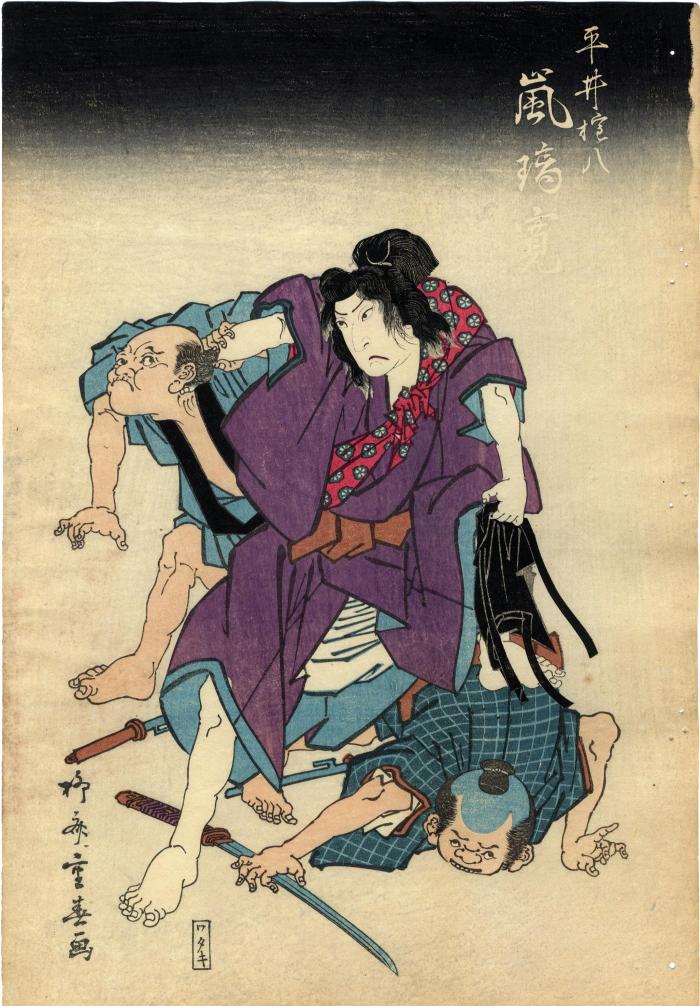Ryūsai Shigeharu (柳斎重春) (artist 1802 – 1852)
Arashi Rikan II (嵐璃寛) in the role of Hirai Gonpachi (平井権八) in the play Hiyokumon Sato no Nishiki-e (双紋廓錦絵) or A brocade picture of lovers' crests in the pleasure quarters
1835
10.25 in x 14.75 in (Overall dimensions) Japanese woodblock print
Signed: Gyokuryūtei Shigeharu ga (?)
玉柳亭重春画
Publisher: Wataya Kihei
(Marks 579 - seal 25-056)
Museum of Fine Arts, Boston - 1835 Ashiyuki print of the same actor in the same role
Lyon Collection - a Hokuei print from this same play "Hiyokumon sato no nishiki-e (A brocade picture of lovers' crests in the pleasure quarters: 双紋廓錦絵) was one of a series of popular Gonpachi Komurasaki mono (plays about Gonpachi and Komurasaki: 権八小紫物) based on actual tales involving unrelated historical figures. The samurai Shirai Gonpachi (白井権八)—in the play he was called Hirai Gonpachi: 平井権八) [sic]—was guilty of murder and robbery, and was executed in 1679....
The theatrical story features Gonpachi who was — by age 16 — famous for his good looks, bravery, and swordsmanship. He kills a fellow samurai and flees to Edo, where at an inn he is warned by a 15-year-old beauty named Komurasaki that the owner is a gang leader plotting to murder him for his sword. Gonpachi swiftly kills all ten of the gang. Afterwards he visits the Yoshiwara pleasure quarter and finds Komurasaki at the Miuraya brothel, now a prostitute selling herself to earn money for her destitute parents. Without the funds to ransom her, Gonpachi turns to a life of debauchery, supporting himself by robbery and murder. When he is finally captured and executed, the devoted Komurasaki takes her life at his grave. To honor their memory, sympathetic citizens build a tumulus called hiyokuzuka ("lovers' tomb") and temple priests carve a picture of the Hiyoku no tori (比翼鳥), a mythical love-bird — both male and female, each with one eye and one wing — that when flying join as one sex, symbolizing connubial love and fidelity."
This information was taken directly from OsakaPrints.com.
****
"In 1679 a rōnin by the name of Hirai Gonpachi, a regular visitor to the Yoshiwara, was beheaded on the execution ground in Shinagawa. When he was sixteen years of age Gonpachi was said to have killed a man in his home province and subsequently escaped to Edo. Gonpachi followed this violent act by a series of thefts and murders in Edo until he was caught and executed. He would have been a criminal of no consequence, except for the legend that connected him with Komurasaki. The fictionalized story tells us that Komurasaki was deeply in love with Gonpachi (last name Shirai in fiction), who was reputed to be extremely handsome. The legend says that, after his death, she had her wealthy patron purchase her contract. The night of her release, she went to the cemetery of her lover and ended her life with a sharp knife."
Quoted from: Yoshiwara: The Glittering World of the Japanese Courtesan by Cecilia Segawa Seigle, p. 89.
****
This print probably is commemorating a performance at the Naka Theater in Osaka in 8/1835. Many other artists created images based on the same performance. See the Ashiyuki print which we have added as a jpeg below the main image on this page.
actor prints (yakusha-e - 役者絵) (genre)
Kyōto-Osaka prints (kamigata-e - 上方絵) (genre)
Arashi Rikan II (二代目嵐璃寛: 9/1828 - 6/1837) (actor)
Wataya Kihei (綿屋喜兵衛) (publisher)
Shirai Gonpachi (白井権八) (role)
